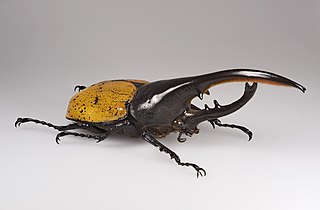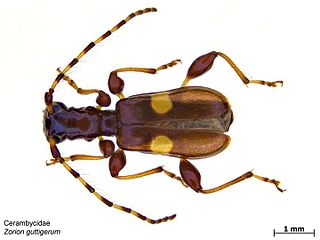
Beetles are insects that form the order Coleoptera, in the superorder Holometabola. Their front pair of wings are hardened into wing-cases, elytra, distinguishing them from most other insects. The Coleoptera, with about 400,000 described species, is the largest of all orders, constituting almost 40% of described insects and 25% of all known animal species; new species are discovered frequently, with estimates suggesting that there are between 0.9 and 2.1 million total species. Found in almost every habitat except the sea and the polar regions, they interact with their ecosystems in several ways: beetles often feed on plants and fungi, break down animal and plant debris, and eat other invertebrates. Some species are serious agricultural pests, such as the Colorado potato beetle, while others such as Coccinellidae eat aphids, scale insects, thrips, and other plant-sucking insects that damage crops. Some others also have unusual characteristics, such as fireflies, which use a light-emitting organ for mating and communication purposes.

The Hercules beetle is a species of rhinoceros beetle native to the rainforests of southern Mexico, Central America, South America, and the Lesser Antilles. It is the longest extant species of beetle in the world, and is also one of the largest flying insects in the world.

Dynastes tityus, the eastern Hercules beetle, is a species of rhinoceros beetle native to the Eastern United States. The adult's elytra are green, gray or tan, with black markings, and the whole animal, including the male's horns, may reach 60 mm (2.4 in) in length. The larvae feed on decaying wood from various trees.

Morimus funereus is a species of beetle in family Cerambycidae. It is found in Greece, North Macedonia, Albania, Belgium, Croatia, Slovenia, the Czech Republic, Germany, Hungary, Italy, Moldova, Romania, Bulgaria, Serbia, Montenegro, Slovakia, Ukraine, Türkiye and Bosnia and Herzegovina. It is somewhat similar to another cerambycid, Rosalia alpina, which however is narrower and has three pairs of black spots. Also Herophila tristis has a similar body shape and markings, but the antennal segments 2 and beyond are much shorter.

Oiceoptoma noveboracense is a member of the family Silphidae, or carrion beetles, which feed on decaying organic matter such as dead animals. Its common name is the margined carrion beetle, from the orange-red margins on the pronotum, which are helpful when identifying this species. The larva is typically light brown to red and also has vertical ridges on its thorax like the adult. This diurnal beetle can be found mainly in the spring into the fall, and it has a strong preference towards a deciduous forest habitat. The primary forensic importance of this beetle is its ability to use the succession of insect fauna to provide confirmation of postmortem intervals.

Pachyta quadrimaculata is a species of the Lepturinae subfamily in long-horned beetle family.

Exosoma lusitanicum, the daffodil leaf beetle, is a species of skeletonizing leaf beetles belonging to the family Chrysomelidae, subfamily Galerucinae.

Chlorophorus sartor is a species of beetle of the family Cerambycidae, subfamily Cerambycinae.

Clytus rhamni is a species of round-necked longhorn beetle belonging to the family Cerambycidae, subfamily Cerambycinae.

Pseudovadonia livida, the fairy-ring longhorn beetle, is a beetle species of flower longhorns belonging to the family Cerambycidae, subfamily Lepturinae.

Stenurella bifasciata is a species of beetle in the family Cerambycidae.

Chlorophorus varius, the grape wood borer, is a species of beetle in the family Cerambycidae.

Styloxus fulleri is a species of beetle in the family Cerambycidae. It was described by George Henry Horn in 1880.

Oberea pupillata is a species of beetle in the family Cerambycidae. It was described by Leonard Gyllenhaal in 1817, originally under the genus Saperda.

Cerambyx welensii is a species of beetle in the family Cerambycidae.

Alosterna tabacicolor is a species of beetle in family Cerambycidae.

Cionus hortulanus is a species of weevils belonging to the family Curculionidae, subfamily Curculioninae.

Chlorophorus figuratus is a species of round-necked longhorns belonging to the family Cerambycidae, subfamily Cerambycinae.

Dasytes gonocerus is a species of soft wing flower beetles belonging to the family Melyridae.

Zorion is a genus of longhorn beetle of the family Cerambycidae that is endemic to New Zealand. About 10 species are currently recognised.




















